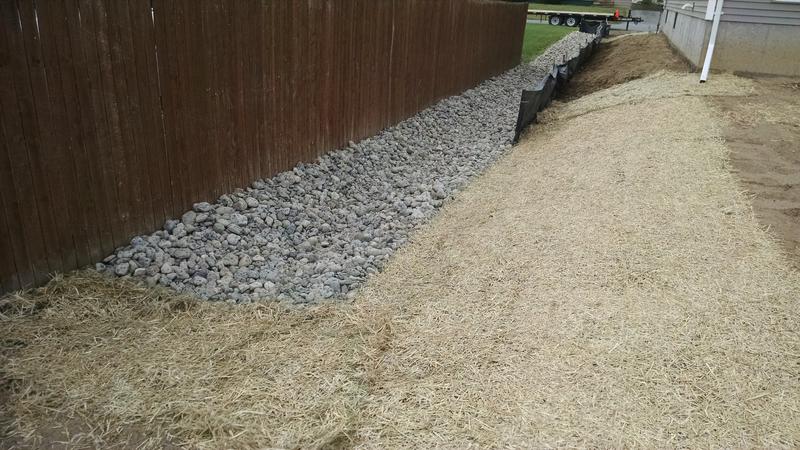Do You Have Standing Water On Your Property?
Is Water Getting Into Your Basement?
If so, you may need a drainage system.
Contour Landscaping will give you a solution to your problem
and get the problem fixed right the first time.
Water “pooling”/“standing” or excessively wet areas on the property:
Lawn, landscaping, patios, driveways, near the foundation of a house, etc.
Foundation - water mitigation:
Large volumes of water from a roof and gutter downspouts during heavy rainstorms can have detrimental effects to a home’s foundation. Water seepage into the basement area of a home can occur if not diverted far enough away from the foundation.
Excessive runoff - water mitigation:
Runoff water can have a problematic effect to your property. It can cause soil erosion, excessive amounts of water in usable areas of the landscape and excessive amounts of runoff water can find its way into the basement of your home.
What Kind of Drainage Issue Are You Having?
A Typical Drainage System Will Have 3 Functions:
Collecting Excess Water
By using catch basins, perforated plastic pipes (pipes with holes) and clear draining gravels, excess water can be collected from surface and sub-surface areas of the property. Water from lawn, landscaping, patio, driveway or near the foundation of a home can be collected for removal.
Diverting Excess Water
Plastic pipes designed to be buried in the ground are the most common method to channel water from the collection area to the dispersal area. Once installed these pipes are hidden underground and will last for decades to come.
Dispersing Excess Water
When a buried drainage pipe can drain to “daylight” (where the end of the pipe exits the ground) and the water can continue to flow away from the collection area, this is ideal. Since the water can exit the pipe and continue to flow away from the collection area this system has the ability to disperse as much water as the pipe can handle for an unlimited period of time. Other methods of excess water dispersal utilize leach fields and drywells. Leach fields and drywells are underground dispersal areas that can hold a set volume of water and gradually the water can leach into the surrounding soil. The holding capacity of a leach field or drywell is calculated based on the amount of water it will receive over a given period of time. The intake of drainage water in a leach field or drywell must not exceed system capacity, a properly designed system will allow enough time for the water in the leach field or drywell to leach into the surrounding soil before this occurs.
• Sloping the soil away from foundation walls of a structure can prevent storm water from seeping into the basement area of a home.
• Filling low areas of a landscape with soil can allow water to runoff to other less desirable areas and/or it can provide drainage within that soil if it’s a well-drained sandy soil.
• The use of culverts (open ditches) and earth berms can be used to direct the flow of water through a landscape.
Simple Fixes
Correcting the soil grade can sometimes solve drainage issues:
Beware of Basement “Waterproofing” Contractors
A basement “waterproofing” system that does not attempt to prevent water from entering the basement on the outside should be scrutinized! Some “waterproofing” contractors will sell very expensive interior “waterproofing” systems that allow water to enter and degrade the foundation of the home then remove the water from the inside of the basement using sump pumps. Granted there are instances where interior water removal may be necessary, but only after all exterior options have been exhausted. If a basement “waterproofing” contractor does not mention exterior options that can be done in place or in combination with their interior system or if they fail to mention exterior factors contributing to water/moisture issues in the basement then STOP. . . give Contour Landscaping a call today, get the honest truth, even if it means we don’t offer the service you need.
Sloping the soil away from the house foundation and into a river rock filled culvert allowed this client to save several thousands of dollars versus a retaining wall. All storm water from the roof/gutters will runoff into the culvert area and be kept off the adjacent property.
Foundation Drainage
Roof Water Mitigation
Foundation Drainage
Gutter Water Mitigation
Do You Have Wet Lawn Areas?
Gravel drains can be used to collect, divert and disperse excessive surface and sub-surface water.
This is actually the after photo taken the day of job completion. All lawn sod was replaced and there was little to no signs that any work had been performed.
Do You Have "Standing" or "Pooling" Water?
Catch basins can be used to collect surface water from low areas of the property.
Draining Water to "Daylight"
When a system can continually flow out the end of the pipe it has unlimited draining capacity.
Chamber Leach Fields
These underground systems hold and leach drainage water into the surrounding soil.
Basic Gravel Drywell
A gravel drywell is a pit filled with clear draining gravel for holding and leaching drainage water.
Drainage
Call Now! (518) 396-9353
Serving the Capital District of N.Y.






